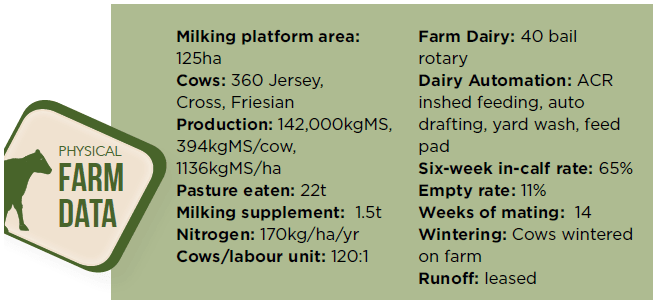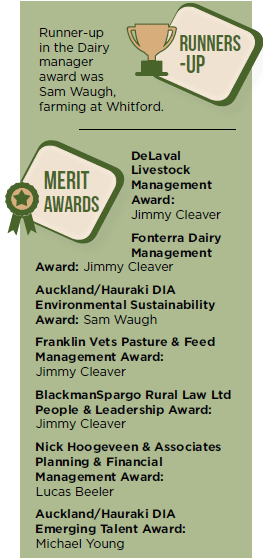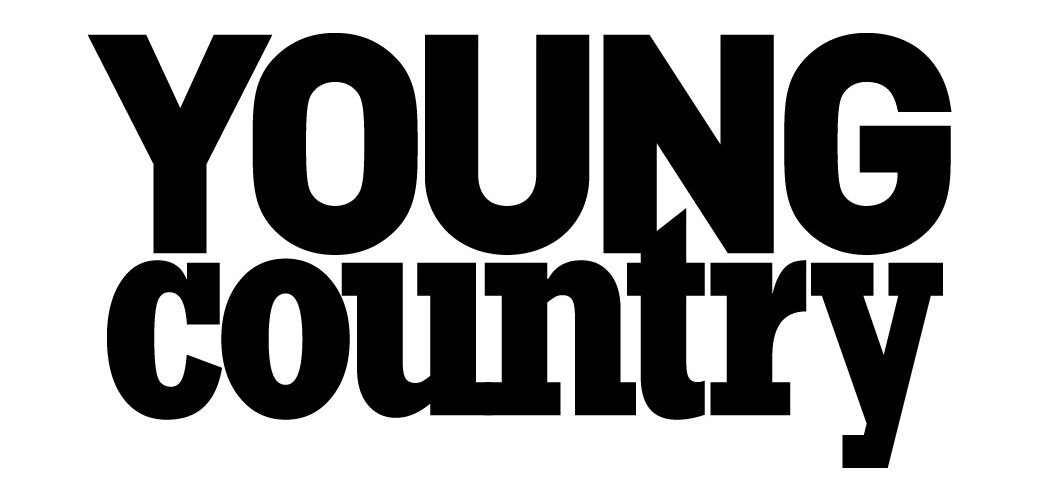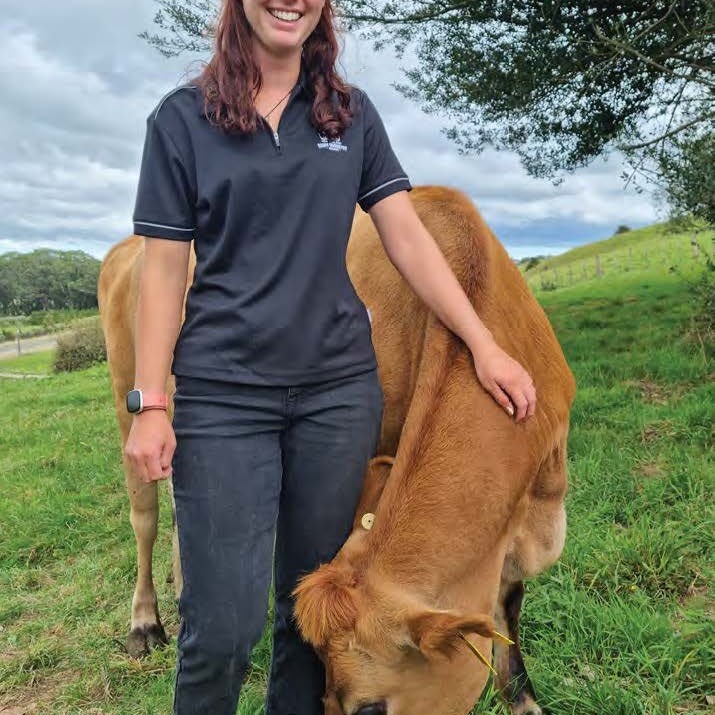By Claire Ashton
 Auckland Hauraki Dairy Manager winner Jimmy Cleaver is in his second season on rolling farmland close to the Waikato River at Rangiriri for Grant Clune, who headhunted him to work as his farm manager.
Auckland Hauraki Dairy Manager winner Jimmy Cleaver is in his second season on rolling farmland close to the Waikato River at Rangiriri for Grant Clune, who headhunted him to work as his farm manager.
He grew up in the district and his parents are drystock farmers, but school holidays spent at his grandparent’s dairy farm in Waiau Pa, Clarks Beach, grew his interest in dairying. He would get in the pit and see what was happening and help feed the calves and this early experience, combined with the clear career progression of dairying is what attracted him into the industry.
Jimmy holds a Telford Certificate in Agriculture (with Distinction), from Lincoln University which he considers to be very valuable. There he picked up three awards for shearing, engineering, and best overall dairy student. He also has completed courses with Primary ITO; Milk Quality Stage 2, and Effluent Level 3 and 5. A Dairy Masters course in New Plymouth with Milk Map Consulting continued Jimmy’s professional development and knowledge base. He is also part of North Waikato Young Farmers.
 For his work experience he went to a farm in Gore owned by James Matheson, who placed second at the National DIA Awards in 2019, and who inspired Jimmy to enter the awards and taught him about the numbers side of farming.
For his work experience he went to a farm in Gore owned by James Matheson, who placed second at the National DIA Awards in 2019, and who inspired Jimmy to enter the awards and taught him about the numbers side of farming.
“It was after meeting James that I clicked that I could actually be a farm manager at a young age, (19) because he was young as well. He also threw me in the deep end, and when I was half-way through the course, he left me to look after the farm in the weekends, in a ‘sink or swim’ kind of style.”
Jimmy entered the DIA in 2021. That first year he went in with an open mindset and to see what he could learn and improve on, with the aid of the judge’s perspective. He decided to enter again this year as the farm had a very good production year and being in his second season, he could make comparisons and track changes. Pasture management was his area of greatest improvement and he received the merit award for Franklin Vets Pasture & Feed Management.
“Due the clay soils and irrigation system, after we dry off we draft, and put the lighter stock on the hills over winter to avoid pugging.”
Consented irrigation (being alongside the river) means they grow grass all year round, and Jimmy acknowledges, “Sure there is time spent moving K-lines but that time would be spent feeding out otherwise.”
Monitoring of pasture growth rates, and regular pasture walks are routine. Jimmy admits occasionally he can get it wrong but will always learn from that.
He hosted his Young Farmers group on a Farm Tour, and his non-traditional pasture management was questioned, particularly around rotational grazing. The proof, however, was not only in increased production, (up by 40kg milksolids (MS)/ cow last season) but overall, with robust animal health – all without any extra feed input.
“Offer them 120% of what you think they will eat in order to keep the cows fully fed which will leave a higher residual,” Jimmy says.
The system 4 farm uses in-shed feeders, feeding maize and palm kernel on the feedpad.
“The owner, Grant, is looking for a good Kiwi Cross sort of cow – we have Jersey, Friesian, Crossbreds and everything in-between. “ It is a closed system, buying in four Jersey bulls to put over the heifers and using AB.
Every cow is reared onfarm, with a beef run-off up the road which also helps to prevent biosecurity issues.
Jimmy has connected up with someone in his Young Farmer group interested in genetics who is sharemilking and Jimmy is keen to learn from him. At Telford, he spent a week with a farmer who pointed out the breeding traits handpicking bulls can provide to breed for a good teat placement for example. He is a trained AI technician too which helps with breeding – they do six weeks of AI then Herefords, then the Jersey bull goes in.
Milking through a herringbone shed with just 17 rows made milking a real challenge, so the farm purchased a second hand 10-year old 40-bale rotary shed from Te Kauwhata and shifted it to Rangiriri. Jimmy was able to have some input on the set up of the shed and is thankful Grant is open to his suggestions.
The shed was commissioned in December 2021 with three days to get the cows adjusted from the herringbone. To manage this Jimmy kept the gates’ entry and exit points consistent. A fortuitous opportunity has come Jimmy’s way, as soon after Grant purchased an additional 20ha, a retiring farm owner and neighbour wanted to sell his herd, so with a combination of savings, a loan, and a business plan, Jimmy at 22 years old will be the proud owner of 66 cows.
The cows come from a 50-year-old herd, and Jimmy is excited to be well on his way to building his herd come June 1.
The herd size will then total 426 on twice-a-day milking, with two full-time farmworkers. Six of the cows are already in the herd.
Riparian planting is a goal due to the high volume of waterways onfarm, and thus far they have achieved about 80%. “We had three guys out here for three weeks planting.”
Getting off-farm for Jimmy usually involves a hunting, fishing, or diving expedition and he has ranged as far afield as Stewart Island, Wanaka, and Lake Tekapo (where he shot a notable Tahr stag). He is looking forward to the week at Nationals in Christchurch and will fit in a hunt while he is down there.




